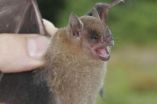(Press-News.org) Lying forgotten in museum collections two new species of yellow-shouldered bats have been unearthed by scientists at the American Museum of New York and The Field Museum of Natural History and described in the open access journal ZooKeys. These two new additions to the genus Sturnira are part of a recent discovery of three bats hidden away in collections around the world, the third one still waiting to be officially announced.
Up until recently the genus Sturnira was believed to contain only 14 species. In the last years closer morphological and molecular analysis have revealed an unexpected species richness in the genus. Sturnira now includes 22 described species, making it the most speciose genus in the Neotropical bat family Phyllostomidae.
Phyllostomidae, or the New World leaf-nosed bats are exclusively found in the biodiversity rich tropical areas of Central and South America. Both the scientific and common names of these bats refer to their often large, lance-shaped noseleaves. Because these bats use echolocation to orientate in the darkness the "nose-leaf" is thought to serve some role in fine-tuning their call.
All species in the yellow-shouldered genus Sturnira are frugivorous which means they feed largely on fruit. They are endemic to the Neotropics where they inhabit tropical lowland and montane forests. In fact the greatest diversity in the genus occurs on the elevated forested slopes of the Andes where at least 11 species occur.
The two newly described species, Sturnira bakeri and Sturnira burtonlimi occur in western Ecuador and in Costa Rica and Panama. The reason why they went unrecognized in collections is a superficial resemblance with other species in the genus, most of which were described without adequate illustrations to communicate identifying characteristics. Only after an in-depth molecular analysis that included over 100 samples from most of the species of the genus could the new species be identified. "Modern electronic publications like ZooKeys permit extensive and detailed color photography to accompany taxonomic descriptions. Any reader can easily and clearly appreciate the character states we use to distinguish these new taxa" said co-author Bruce Patterson.
INFORMATION:
Original Source:
Velazco PM, Patterson BD (2014) Two new species of yellow-shouldered bats, genus Sturnira Gray, 1842 (Chiroptera, Phyllostomidae) from Costa Rica, Panama and western Ecuador. ZooKeys 402: 43-66. doi: 10.3897/zookeys.402.7228
Two new species of yellow-shouldered bats endemic to the Neotropics
2014-04-16
ELSE PRESS RELEASES FROM THIS DATE:
Researchers: Obesity can amplify bone and muscle loss
2014-04-16
TALLAHASSEE, Fla. – Florida State University researchers have identified a new syndrome called "osteosarcopenic obesity" that links the deterioration of bone density and muscle mass with obesity.
"It used to be the thinking that the heavier you were the better your bones would be because the bones were supporting more weight," said Jasminka Ilich-Ernst, the Hazel Stiebeling Professor of Nutrition at Florida State. "But, that's only true to a certain extent."
The syndrome, outlined in the May issue of Ageing Research Reviews, explains how many obese individuals experience ...
Researchers develop a new drug to combat the measles
2014-04-16
A novel antiviral drug may protect people infected with the measles from getting sick and prevent them from spreading the virus to others, an international team of researchers says.
Scientists from the Institute for Biomedical Sciences at Georgia State University, the Emory Institute for Drug Development and the Paul-Ehrlich Institute in Germany developed the drug and tested it in animals infected with a virus closely related to one that causes the measles. As reported in the current issue of the journal Science Translational Medicine, virus levels were significantly ...
Celldex's Phase 1 study of CDX-1401 published in Science Translational Medicine
2014-04-16
HAMPTON, NJ (April 16, 2014): Celldex Therapeutics, Inc. (NASDAQ: CLDX) announced today that final data from its Phase 1 study of CDX-1401 in solid tumors, including long-term patient follow-up, have been published in Science Translational Medicine (Vol 6 Issue 232). The data demonstrate robust antibody and T cell responses and evidence of clinical benefit in patients with very advanced cancers and suggest that CDX-1401 may predispose patients to better outcomes on subsequent therapy with checkpoint inhibitors. CDX-1401 is an off-the-shelf vaccine consisting of a fully ...
Meteorites yield clues to red planet's early atmosphere
2014-04-16
Geologists who analyzed 40 meteorites that fell to Earth from Mars unlocked secrets of the Martian atmosphere hidden in the chemical signatures of these ancient rocks. Their study, published April 17 in the journal Nature, shows that the atmospheres of Mars and Earth diverged in important ways very early in the 4.6 billion year evolution of our solar system.
The results will help guide researchers' next steps in understanding whether life exists, or has ever existed, on Mars and how water—now absent from the Martian surface—flowed there in the past.
Heather Franz, ...
Mutant protein in muscle linked to neuromuscular disorder
2014-04-16
Sometimes known as Kennedy's disease, spinal and bulbar muscular atrophy (SBMA) is a rare inherited neuromuscular disorder characterized by slowly progressive muscle weakness and atrophy. Researchers have long considered it to be essentially an affliction of primary motor neurons – the cells in the spinal cord and brainstem that control muscle movement.
But in a new study published in the April 16, 2014 online issue of Neuron, a team of scientists at the University of California, San Diego School of Medicine say novel mouse studies indicate that mutant protein levels ...
Study provides crucial new information about how the ice ages came about
2014-04-16
An international team of scientists has discovered new relationships between deep-sea temperature and ice-volume changes to provide crucial new information about how the ice ages came about.
Researchers from the University of Southampton, the National Oceanography Centre and the Australian National University developed a new method for determining sea-level and deep-sea temperature variability over the past 5.3 million years. It provides new insight into the climatic relationships that caused the development of major ice-age cycles during the past two million years.
The ...
Searching for dark energy with neutrons
2014-04-16
All the particles we know to exist make up only about five per cent of the mass and energy of the universe. The rest – "Dark Matter" and "Dark Energy" – remains mysterious. A European collaboration lled by researchers from the Vienna University of Technology has now carried out extremely sensitive measurements of gravitational effects at very small distances at the Institut Laue-Langevin (ILL) in Grenoble. These experiments provide limits for possible new particles or fundamental forces, which are a hundred thousand times more restrictive than previous estimations.
Undiscovered ...
Ancient shark fossil reveals new insights into jaw evolution
2014-04-16
The skull of a newly discovered 325-million-year-old shark-like species suggests that early cartilaginous and bony fishes have more to tell us about the early evolution of jawed vertebrates—including humans—than do modern sharks, as was previously thought. The new study, led by scientists at the American Museum of Natural History, shows that living sharks are actually quite advanced in evolutionary terms, despite having retained their basic "sharkiness" over millions of years. The research is published today in the journal Nature.
"Sharks are traditionally thought to ...
Scientists re-define what's healthy in newest analysis for Human Microbiome Project
2014-04-16
ANN ARBOR, Mich. – As scientists catalog the trillions of bacteria found in every nook and cranny of the human body, a new look by the University of Michigan shows wide variation in the types of bacteria found in healthy people.
Based on their findings in today's
Nature, there is no single healthy microbiome. Rather each person harbors a unique and varied collection of bacteria that's the result of life history as well their interactions with the environment, diet and medication use.
"Understanding the diversity of community types and the mechanisms that result ...
Sperm meets egg: Protein essential for fertilization discovered
2014-04-16
Researchers at the Wellcome Trust Sanger Institute have discovered interacting proteins on the surface of the sperm and the egg essential to begin mammalian life. These proteins, which allow the sperm and egg to recognize one another, offer new paths towards improved fertility treatments and the development of new contraceptives.
Fertilisation occurs when an egg and a sperm recognise each other and fuse together to form an embryo. The Izumo protein displayed on the sperm that recognises the egg was identified in 2005 by Japanese researchers who named it Izumo, after a ...






